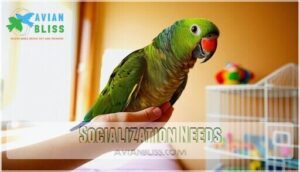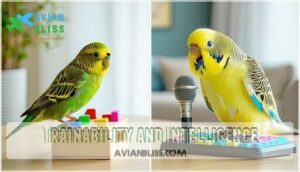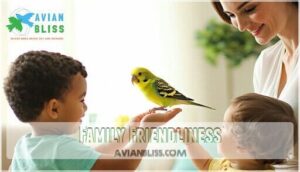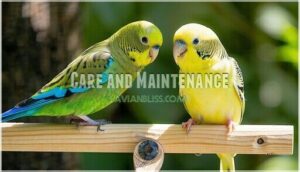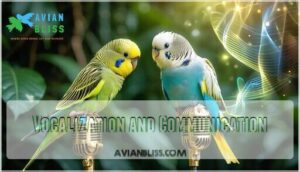This site is supported by our readers. We may earn a commission, at no cost to you, if you purchase through links.

Parrotlets are tiny dynamos with big attitudes—think of them as pocket-sized macaws who don’t know they’re small.
They’re bold, independent, and prefer being the only bird in your life.
Parakeets, on the other hand, are social butterflies who thrive in groups and master human speech with impressive skill.
If you want a fierce, one-on-one companion who’ll rule your roost, parrotlets fit the bill.
If you prefer chatty, entertaining flocks that adapt to busy households, parakeets shine.
Your lifestyle determines which feathered friend matches your home’s energy.
Table Of Contents
- Key Takeaways
- Parrotlet Vs Parakeet
- Breed Comparison
- Pet Suitability
- Care and Maintenance
- Vocalization and Communication
- Ownership Costs
- Frequently Asked Questions (FAQs)
- Should I get a parakeet or parrotlet?
- Is a parrotlet a good first bird?
- What are the cons of a parrotlet?
- Are parrotlets good beginner birds?
- Are parrotlets louder than budgies?
- Can parrotlets talk?
- Can parrotlets coexist with other pets?
- How do parakeets respond to new environments?
- What common health issues affect parrotlets?
- Are parakeets suitable as first pets?
- Conclusion
Key Takeaways
- You’ll get different personalities: Parrotlets are bold, territorial tiny dynamos that prefer being your only bird, while parakeets are gentle, social butterflies who thrive in groups and adapt well to busy households.
- Your experience level matters: Parrotlets need experienced owners who can handle their assertive, nippy nature and daily socialization requirements, while parakeets make excellent first pets with their forgiving, docile temperament.
- You’re choosing between speech styles: Parakeets excel at clear speech and can learn hundreds of words, while only 30% of parrotlets develop talking ability with softer, more robotic-sounding voices.
- Your budget considerations differ significantly: Parrotlets cost $150-400 upfront but live 15-20 years, while parakeets cost just $20-60 initially but have shorter 5-15 year lifespans, making long-term value calculations important.
Parrotlet Vs Parakeet
When you’re choosing between a parrotlet and a parakeet, you’ll notice clear differences in size, personality, and care needs.
Parrotlets pack big attitudes into tiny 4-5 inch bodies, while parakeets offer gentler temperaments in their slightly larger 7-8 inch frames.
Don’t let size fool you—parrotlets are feisty powerhouses while parakeets bring sweet, social charm.
Physical Characteristics
Anyone can spot the differences between these tiny feathered friends with careful observation.
Parrotlet size averages 4.5-5.5 inches with a stocky build, while parakeets stretch 7-8 inches with slender frames.
Their tail length tells the story—parrotlets sport short, square tails versus parakeets’ long, pointed ones.
| Feature | Parrotlet | Parakeet |
|---|---|---|
| Beak Shape | Stout, curved | Smaller, less pronounced |
| Color Patterns | Solid greens, blues, yellows | Striped head/wings, varied mutations |
| Feather Differences | Compact, vivid patches | Barred patterns, extensive color range |
Lifespan and Size
When you’re choosing between these birds, size differences and average lifespan matter substantially.
Parakeets grow larger at 7-8 inches, while parrotlets stay compact at 4.5-5.5 inches. However, parrotlets win the longevity game with 15-20 years versus parakeets’ 5-15 years.
A key factor influencing a parakeet’s lifespan is consistent veterinary care. Both reach maturity around 6-8 months with similar growth rates.
| Comparison Factor | Parrotlet | Parakeet |
|---|---|---|
| Average Lifespan | 15-20 years | 5-15 years |
| Adult Size | 4.5-5.5 inches | 7-8 inches |
| Weight Comparison | ~30 grams | 30-40 grams |
| Maturity Timeline | 6-8 months | 6-8 months |
Color Variations
Which colors will catch your eye when choosing between these vibrant birds? Both species offer stunning color mutations that make each bird unique.
| Feature | Parrotlet Colors | Parakeet Colors |
|---|---|---|
| Common Colors | Green, blue, yellow, turquoise | Green, blue, yellow, white, pink |
| Rare Colors | Lutino, albino, fallow mutations | Violet, rainbow, spangle patterns |
| Feather Patterns | Uniform coloring, minimal striping | Distinctive stripe patterns, varied markings |
Parrotlet vs budgie color variations show interesting differences in color inheritance. Parrotlets display more uniform feather patterns, while parakeet colors feature complex striping. Color mutations in both species create hybrid colors through selective breeding, offering collectors rare specimens with unique genetic combinations.
Breed Comparison
When you’re choosing between these two popular pet birds, their personalities couldn’t be more different.
Parrotlets pack big attitudes into tiny bodies with bold, territorial tendencies, while parakeets offer gentle, social companionship that’s perfect for beginners, exhibiting gentle characteristics.
Temperament and Personality
These two species display distinctly different personality profiles that directly impact your daily interactions.
Parrotlets pack bold, assertive personalities into tiny frames, while parakeets bring gentle, social charm to every encounter.
Tiny powerhouses with Napoleon complexes versus gentle social butterflies—choose your feathered personality match.
| Trait | Parrotlet | Parakeet |
|---|---|---|
| Bonding Potential | Forms intense single-person bonds | Bonds with multiple family members |
| Docility Levels | Feisty and independent | Calm and agreeable |
| Handling Differences | Requires daily interaction to prevent nipping | Naturally receptive to gentle handling |
| Territorial Tendencies | Strong guarding of space and objects | Minimal territorial behavior |
Parrotlet personality traits lean toward dominance and self-reliance, making them fascinating but challenging companions.
Their territorial tendencies can surprise new owners when these pocket-sized birds display outsized attitudes.
Parakeet personality characteristics emphasize cooperation and adaptability, creating more predictable interactions.
Understanding these temperament differences helps you choose the bird personality traits that match your lifestyle and experience level.
Socialization Needs
Understanding bird social needs makes all the difference in your pet’s happiness.
Parakeet personality thrives on companionship, while parrotlet personality leans toward independence.
Both birds are intelligent and trainable, but their temperaments differ substantially.
| Aspect | Parrotlet | Parakeet |
|---|---|---|
| Single vs Pairs | Prefer solo living | Thrive in pairs |
| Human Interaction | Daily handling essential | Needs social engagement |
| Introducing Birds | Often territorial | Generally accepting |
Social birds like parakeets require either bird companions or extensive human interaction to prevent behavioral issues.
Parrotlets need consistent socialization benefits but can become stressed with excessive attention.
Both species develop problems without proper bird socialization.
Trainability and Intelligence
Training reveals striking differences between these feisty little birds.
Both species show impressive cognitive abilities, but their learning speed and problem solving approaches vary substantially.
| Aspect | Parrotlet | Parakeet |
|---|---|---|
| Learning Speed | Fast initial learning, short attention spans | Steady, enthusiastic learners |
| Trick Complexity | Simple tricks (stepping up, fetch) | Complex behaviors, advanced mimicry |
| Training Methods | Short sessions, daily handling required | Longer sessions, positive reinforcement |
| Intelligence Focus | Problem solving, territorial awareness | Social learning, vocal mimicry |
Parrotlet training demands consistency due to their assertive nature.
Without regular handling, they become nippy and territorial.
Parakeet talking abilities shine through their clear articulation and extensive vocabularies.
Both respond well to positive reinforcement, but parakeets prove more forgiving for beginners.
Pet Suitability
When choosing between these two small parrots, you’ll want to take into account your living situation and experience level.
Parrotlets suit experienced bird owners who can handle their bold personalities, while parakeets work better for families and first-time owners seeking a gentler companion.
Family Friendliness
Parakeets shine as family-friendly companions, especially for first-time bird owners seeking suitable pets for families.
Their gentle nature requires minimal supervision needs around children, while parrotlets demand careful child interaction due to territorial tendencies.
Both species show good pet compatibility, but parakeets better match most family lifestyles with their social, docile temperament compared to parrotlets’ assertive personalities.
Apartment Living
Your living space becomes a sanctuary when you choose apartment-friendly birds.
Parrotlets excel in small spaces due to their compact size and lower noise level compared to larger parrots. Their space requirements are minimal, making parrotlet care manageable in tight quarters.
Parakeets need slightly larger parakeet cage setups but adapt well to apartment living. Both small parrot breeds respect neighbor considerations better than louder species.
Check landlord restrictions before bringing either home, as some buildings prohibit pets. Apartment enrichment through strategic toy placement maximizes their environment without overwhelming your space, considering neighbor considerations.
Noise Level and Exercise Needs
When comparing bird noise level, parakeets vocalize louder at 68-85 decibels versus parrotlets’ quieter 60-80 decibel range.
Both species need daily exercise – parrotlets require 2-3 hours out-of-cage time while parakeets need 1-2 hours.
For apartment suitability, parrotlets create less neighbor disturbance, and mental stimulation through enrichment activities reduces excessive vocalization in both birds.
Care and Maintenance
When you’re choosing between a parrotlet and parakeet, understanding their daily care needs helps you make the right decision for your lifestyle.
Both birds require specific attention to diet, housing, and health, but their maintenance demands differ in important ways.
Dietary Requirements
Nourishing both species requires balancing quality seed pellets with fresh vegetables and controlled portions.
Parrotlets need 60-70% pellets plus calcium supplements, while parakeet diet thrives on varied seed variety with sprouted options.
Fresh foods like leafy greens provide essential vitamins, but avoid toxic foods including avocado and chocolate.
Consider parrotlet seed pellets for ideal nutrition. Practice strict portion control—parrotlets eat 1-2 tablespoons daily.
Cage Setup and Size
Both species need spacious homes, but cage dimensions differ substantially.
Parrotlets require minimum 24x18x24 inches, while parakeets need 30x18x36 inches to accommodate their longer tails and active nature.
A good option is a cage made of durable powder-coated metal for easy cleaning.
- Bar spacing: Use 1/2-inch spacing for parrotlets, 1/2 to 5/8-inch for parakeets to prevent escapes
- Perch variety: Install natural wood branches at different diameters to promote foot health
- Toy placement: Position enrichment items away from food/water dishes to maintain cleanliness
- Vertical space: Prioritize height over width since both species prefer climbing and flying upward
Grooming and Health Checks
Maintaining feather health requires weekly inspections for both species, checking for damage or stress bars.
Parrotlets need gentle misting for ideal condition, while parakeets handle self-preening better. Schedule nail care every 4-6 weeks for parrotlets, 6-8 weeks for parakeets.
Proper trimming requires specialized bird tools. Beak trimming becomes necessary when overgrowth affects eating.
Annual vet visits catch common illnesses early, ensuring your parrotlet lifespan and parakeet lifespan reach their full potential through proper bird grooming and care.
Vocalization and Communication
You’ll notice distinct differences in how these birds communicate, from volume levels to vocabulary potential.
Understanding their vocal patterns helps you choose the right feathered companion for your living situation and interaction preferences.
Parrotlet Sounds and Mimicry
Your parrotlet’s vocalization types include high-pitched chirps, squeaks, and whistles that stay below 50 decibels.
Only 30% develop mimicry abilities, learning up to 10 simple words with consistent training methods.
Their speech clarity lacks the sharpness of larger parrots, producing softer, robotic-sounding communication cues.
Male parrotlet sounds show slightly better vocal birds potential than females.
Parakeet Vocalizations and Speech
Parakeets are vocal birds with impressive talking abilities.
Male budgies excel at speech training, learning hundreds of words with clear vocal clarity.
Their mimicry skills include household sounds, songs, and complex phrases.
Female parakeets also develop speech, though with higher pitch.
Their emotional expression through song repertoire ranges from cheerful chirps to excited chatter when greeting owners, showcasing their ability to learn and mimic complex phrases and produce a wide range of sounds, including household sounds.
Encouraging Vocalization and Interaction
Both species respond well to positive reinforcement during speech training sessions.
Interactive toys keep birds mentally stimulated while vocal rewards encourage mimicry techniques.
Regular bonding activities strengthen your relationship and improve communication.
Parrot enrichment can be achieved with safe climbing structures, which encourage physical activity.
Here are effective bird training techniques:
- Mirror sessions – Place a mirror during bird training sessions to encourage self-directed chatter and vocal practice
- Music exposure – Play upbeat songs during bonding activities to inspire natural vocalizations and rhythmic responses
- Treat timing – Offer vocal rewards immediately after attempted speech or sounds during bird training
- Social eating – Share meals while talking to demonstrate communication patterns and strengthen your bond
- Reading aloud – Use storytelling as interactive toys for the mind, exposing birds to varied speech patterns and tones
Ownership Costs
When you’re choosing between a parrotlet and parakeet, the upfront and ongoing costs can vary substantially between these two species.
Understanding the financial commitment helps you make an informed decision that fits your budget and lifestyle for the next 15-20 years.
Purchase Price and Initial Costs
Beyond their charming chatter, you’ll face real financial decisions when choosing your feathered friend.
Bird price differences are significant between these species. Parrotlet price ranges from $150-$400, while parakeet price stays affordable at $20-$60.
Your initial investment extends beyond the bird itself.
| Cost Category | Parrotlet | Parakeet |
|---|---|---|
| Bird Price | $150-$400 | $20-$60 |
| Cage Cost | $80+ | $40+ |
| Vet Initial | $80-$130 | $50-$100 |
Cage cost, toy expenses, and food budget add up quickly.
Petco budgie prices have seen significant increases recently. Pet ownership requires careful planning for these upfront costs.
Ongoing Expenses and Maintenance
Monthly food costs run $10-40 for both species, with parakeets typically cheaper.
Toy replacement averages $10-30 monthly to prevent boredom.
Vet bills include $40-110 annual checkups, plus emergency visits exceeding $200.
Cage cleaning supplies cost $10-20 monthly.
Travel costs reach $20-50 daily for boarding.
A new parakeet could have high initial costs.
Quality veterinary care and consistent bird health maintenance are essential ongoing investments.
Long-term Commitment and Responsibility
Owning a bird isn’t just about monthly expenses.
You’re committing to 15-20 years of daily care, creating a significant financial burden and lifestyle changes.
Bird ownership experience requires owner preparedness for unexpected challenges like sudden bird health issues.
Your bird care commitment means adjusting your schedule, travel plans, and social life.
This bird lifespan means decades of responsibility ahead, and it requires a deep understanding of the long-term implications of bird ownership.
Frequently Asked Questions (FAQs)
Should I get a parakeet or parrotlet?
Choosing between feathered friends feels like picking between two different personalities in tiny packages.
If you’re a first-time bird owner, parakeets are easier to handle and more social.
However, if you want a bold, loyal companion and have bird experience, consider a parrotlet.
Is a parrotlet a good first bird?
Parrotlets aren’t ideal first birds.
They’re territorial, nippy, and require daily handling from young age to stay friendly.
You’d be better off starting with a parakeet, which is calmer, easier to train, and more forgiving for beginners learning bird care.
What are the cons of a parrotlet?
You’ll face aggressive nipping, territorial behavior, and daily handling requirements. They’re loud when upset, need experienced care, and aren’t suitable for young children or beginners.
Are parrotlets good beginner birds?
Looking for your first feathered friend?
Parrotlets aren’t ideal beginner birds.
They’re territorial, nippy, and need daily handling to stay tame.
Their assertive personalities require experienced owners who understand bird behavior and can commit to consistent socialization.
Are parrotlets louder than budgies?
No, parrotlets aren’t louder than budgies. You’ll find parrotlets are actually quieter, producing soft chirps and clicks. Budgies are much more vocal with cheerful songs and chatter throughout the day.
Can parrotlets talk?
Yes, parrotlets can talk and learn words like "pretty bird" and "peek-a-boo." They’ll mimic sounds with a robotic, squeaky voice that’s adorable but less clear than budgies’ articulate speech.
Can parrotlets coexist with other pets?
Due to their territorial and aggressive nature, you shouldn’t keep parrotlets with other pets like cats, dogs, or birds.
They’ll likely bite or attack, creating stress for everyone involved.
Keep them solo for safety.
How do parakeets respond to new environments?
You’ll notice parakeets adapt gradually to new spaces, taking time to explore cautiously.
They’re naturally curious but need patience as they adjust to different sounds, sights, and routines in unfamiliar surroundings.
What common health issues affect parrotlets?
Up to 25% of captive birds develop respiratory issues, making breathing problems your parrotlet’s biggest health concern.
You’ll also watch for feather plucking, nutritional deficiencies, and bacterial infections throughout their 15-year lifespan.
Are parakeets suitable as first pets?
Parakeets make excellent first pets because they’re gentle, social, and easy to train.
Their docile nature suits beginners perfectly, unlike more territorial birds.
They’re forgiving of mistakes and thrive with basic care.
Conclusion
Choosing between parrotlet vs parakeet is like picking between a fierce warrior and a social diplomat—both excel in different environments.
Parrotlets suit owners wanting devoted, one-bird relationships with bold personalities that demand respect. They’re independent thinkers who prefer solo living arrangements.
Parakeets excel in multi-bird households where their chatty, adaptable nature shines. Consider your lifestyle, noise tolerance, and social preferences.
Both species offer unique rewards, but your home’s energy and your personal commitment level will determine which feathered companion becomes your perfect match with a relationship that requires respect.
- https://a-z-animals.com/animals/comparison/parrotlet-vs-parakeet/
- https://www.omlet.us/guide/parakeets/parakeet_keeping/parakeet_cage_companions/
- https://www.reddit.com/r/Parrotlet/comments/1mv10dv/how_much_humaninteraction_do_parrotlets_require/
- https://avianenrichment.com/index.php/learn/emotional-needs/social-interaction
- https://myrightbird.com/articles/socialization-tips-to-help-your-bird-build-trust-and-confidence


